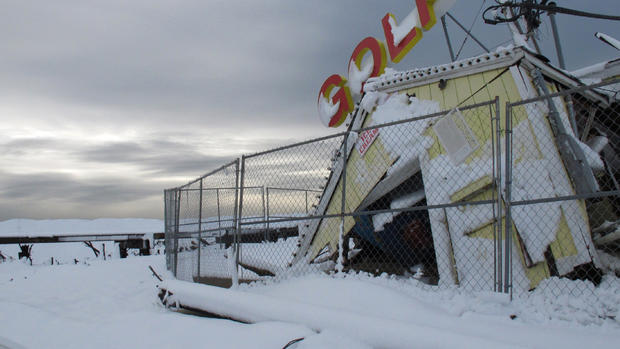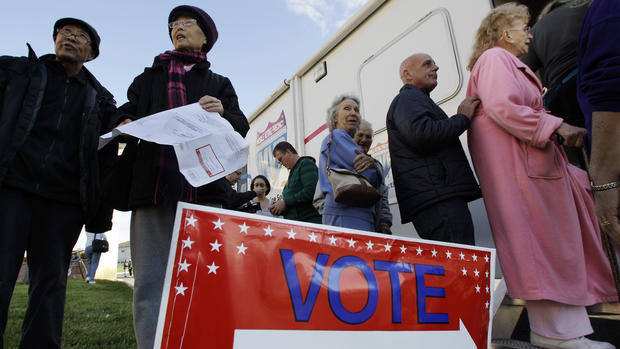Post-Sandy "suckerpunch storm" dumps rain, snow on areas recovering from superstorm
Updated at 12:16 p.m. ET
NEW YORK
The nor'easter that stymied recovery efforts from Superstorm Sandy pulled away from New York and New Jersey Thursday, leaving hundreds of thousands of new people in darkness after a blanket of thick, wet snow snapped storm-weakened trees and downed power lines.
From Brooklyn to storm-battered sections of the Jersey shore and Connecticut, about 750,000 customers — more than 200,000 from the new storm — in the region were without power in temperatures near freezing, some living for days in the dark.
"We lost power last week, just got it back for a day or two, and now we lost it again," said John Monticello of Point Pleasant Beach, N.J. "Every day it's the same now: turn on the gas burner for heat. Instant coffee. Use the iPad to find out what's going on in the rest of the world."
In Belmar, N.J., snow was not a welcome sight, CBS News correspondent Ben Tracy reported on "CBS This Morning" Thursday. A generator runs Belmar resident Nick Symchik's one light and computer. He's gone 10 days without power and is using his oven to heat his house.
To help victims of Sandy, donations to the American Red Cross can be made by visiting Red Cross disaster relief, or you can text REDCROSS to 90999 to make a $10 donation.
"At some point you're going to want to go to sleep at night and you're not going to want to be frozen, so, you know, you leave it on and, you know, you kinda roll the dice," Symchik said.
Mayors along the coast vowed that this so-called "suckerpunch storm" would be just a brief pause in the cleanup, Tracy reports
But most were just grateful the new storm didn't bring a fresh round of devastation.
"For a home without power, it's great. It came through the storm just great," said Iliay Bardash, 61, a computer programmer on Staten Island without electricity since last week. "But things are not worse, and for that I am thankful."
Nearby, Vladimir Repnin emerged from his powerless home with a snow shovel in his hand, a cigarette in his mouth and a question from someone cut off from the outside world.
"Who won? Obama?" he asked.
He didn't like the answer.
"The Democrats ruined my business," he said, referring to his shuttered clothing manufacturing firm.
Unlike other holdouts who got by with generators or gas stoves, the 63-year-old from the Ukraine has been without power since Sandy brought eight feet of water through his door and his neighbor's deck into his yard. He tried to beat the cold Wednesday night by sleeping with his Yorkie Kuzya and cat Channel.
"I had the dog right here," he said, pointing to his left side, "and the cat on my chest. It was still too cold, but I cannot leave my house."
Throughout Staten Island's beach area, the storm had blanketed growing piles of debris with several inches of snow. By mid-morning, it was starting to melt, filling the streets with filthy sludge.
The nor'easter was almost too much for Staten Island resident Lauren Destephano to bear, CBS New York station WCBS-TV reports.
"I cried all day and didn't do much, and now I picked up, put my boots back on and started all over again," Destephano told WCBS-TV.
In her Midland Beach neighborhood, there are still mounds of garbage, WCBS-TV reports. The city and private carters have picked up 130,000 tons of garbage and household debris. Some of it is piled in 20-foot mounds in a parking lot along the storm-ravaged beach.
Roads in New Jersey and New York City were clear for the morning commute, and rail lines into New York were running smoothly so far, despite snow still coming down heavily in some areas.
CBS News hurricane consultant David Bernard reported the storm was moving to the east, delivering 60 mph winds in Martha's Vineyard, Mass., and strong winds in Boston, but not before dumping 13 inches of snow in Freehold, N.J., and 4.7 inches in New York's Central Park among other areas.
Overall, the storm is expected to move out to sea by Thursday night or Friday morning, Bernard reported.
The nor'easter, as promised, brought gusting winds, rain and snow, but not the flooding that was anticipated.
"The good news, thank goodness, is except for maybe 2 inches of snow, there were no other problems," said Randi Savron, 51, a schoolteacher who lives in the Rockaways, one of the areas that flooded badly last week. The idyllic beachfront boardwalk was loosed from pilings and ended up outside her apartment building door.
She said it seemed like work would continue.
But additional outages could stall recovery efforts, even though utility companies had prepared, adding extra crews ahead of the nor'easter.
In New Jersey, there were about 400,000 power outages early Thursday; 150,000 of those were new. In New York City and Westchester, more than 70,000 customers were without power after the storm knocked out an additional 55,000 customers.
For Consolidated Edison, the extra outages were dealt with swiftly, so there were only about 3,000 additional customers without power from the total Wednesday of 67,000.
"I think we're going to be able to power through. Our objective was to get power restored to everyone by the weekend and we're still working with that goal," said Alfonso Quiroz, a spokesman for the utility.
On Long Island, an area badly battered, there were 125,000 new outages, but about 80,000 were restored, making a total of about 300,000 customers without power. Long Island Power Authority spokesman Mark Gross said the utility was assessing new damage while working to restore outages.
Paul Farash of West Babylon, N.Y. said he got power back after three days and didn't lose it again.
"Whatever I experienced was minimal compared to a whole lot of other people," he said. "I've seen some things. I've heard about some things. and I know some things. And I'm counting my blessings. I'll survive."
Anthony Gragnano, who lives in Lindenhurst, worried the new storm would further stall getting power returned to his flooded family home.
"It's just colder now," he said. "We still don't have heat or power, but aside from a little snow, we're good."
Under ordinary circumstances, a storm of this sort wouldn't be a big deal. But large swaths of the landscape were still an open wound, with the electrical system highly fragile and many of Sandy's victims still mucking out their homes and cars and shivering in the deepening cold. As the storm picked up in intensity Wednesday evening, lights started flickering off again.
Residents from Connecticut to Rhode Island saw 3 to 6 inches of snow on Wednesday. Worcester, Mass., had 8 inches of snow, and Freehold, N.J., had just over a foot overnight. Some parts of Connecticut got a foot or more.
There was good weather news: temperatures over the next few days will be in the 50s in southern New England, said meteorologist Frank Nocera, and on Sunday it could edge into the 60s.
Ahead of the storm, public works crews in New Jersey built up dunes to protect the stripped and battered coast, and new evacuations were ordered in a number of communities already emptied by Sandy. New shelters opened.
All construction in New York City was halted — a precaution that needed no explanation after a crane collapsed last week in Sandy's high winds and dangled menacingly over the streets of Manhattan. Parks were closed because of the danger of falling trees.
Airlines canceled at least 1,300 U.S. flights in and out of the New York metropolitan area, causing a new round of disruptions that rippled across the country.
Sandy killed more than 100 people in 10 states, with most of the victims in New York and New Jersey. Long lines persisted at gas stations but were shorter than they were days ago.

